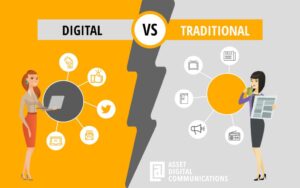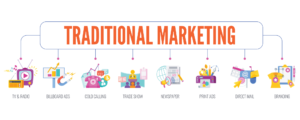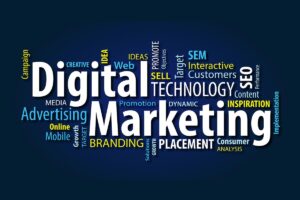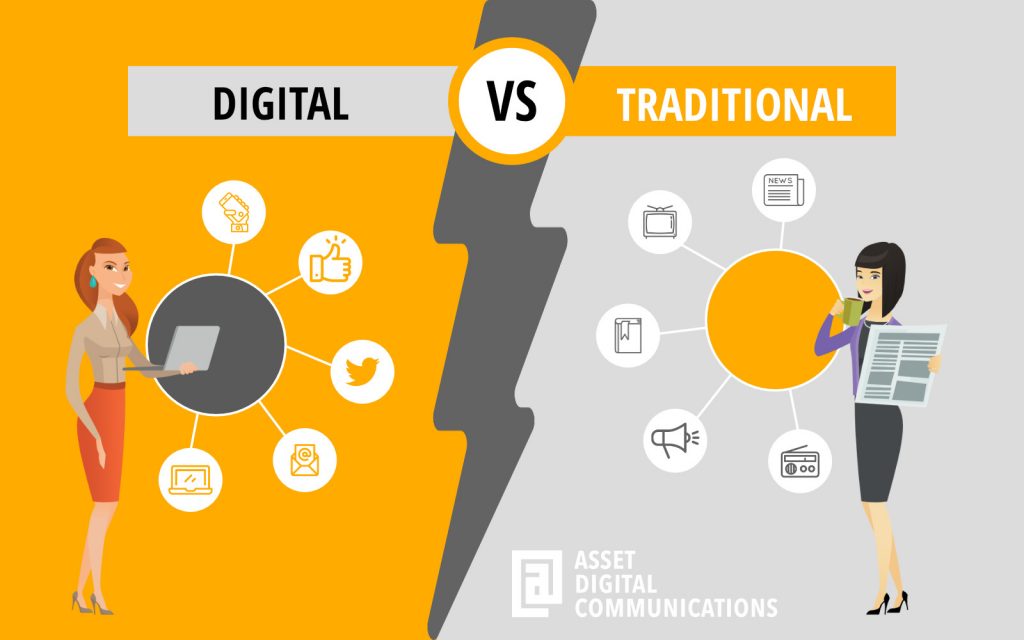Digital Marketing vs. Traditional Marketing
Marketing serves as a crucial link between businesses and their audiences. In today’s dynamic environment, the choice between digital marketing and traditional marketing is a pivotal decision for businesses striving to achieve their goals. Both approaches have distinct benefits and drawbacks, making it essential to understand their differences and potential synergies.

Traditional Marketing
Traditional marketing relies on established, offline methods to reach audiences. Examples include television and radio advertisements, print media (newspapers, magazines, brochures), billboards, direct mail, and in-person promotions.

Advantages:
- Tangible Presence: Physical materials such as brochures and billboards create a memorable and lasting impression.
- Local Targeting: Ideal for connecting with regional audiences through community-focused channels like local newspapers and radio.
- Trust Factor: Traditional media often holds more credibility among older generations.
- Impactful Messaging: Iconic campaigns on TV or billboards can leave a powerful impression through striking visuals or slogans.
Disadvantages:
- High Costs: Expenses for TV ads, print space, and billboards can strain budgets.
- One-Way Communication: Lacks interaction with the audience, making it less engaging.
- Measurement Challenges: Difficult to quantify the success or reach of campaigns.
Digital Marketing
Digital marketing involves online strategies such as social media advertising, search engine optimization (SEO), email marketing, website content, and mobile apps. The internet’s global reach has transformed how businesses connect with their audiences.

Advantages:
- Budget-Friendly: Campaigns can be adjusted to suit budgets, making it accessible for businesses of all sizes.
- Precision Targeting: Tools like Google Ads and social media platforms enable targeting based on demographics, location, and user behavior.
- Data-Driven Insights: Analytics platforms provide detailed insights, tracking metrics like click-through rates, conversions, and ROI.
- Audience Engagement: Interactive platforms like Instagram and Twitter allow businesses to communicate directly with customers.
- Global Accessibility: Digital campaigns can reach audiences across the world, breaking geographical barriers.
Disadvantages:
- Crowded Market: The vast number of online advertisers makes it challenging to stand out.
- Tech Dependency: Campaigns are vulnerable to technical glitches, server issues, or algorithm changes.
- Privacy Concerns: Growing awareness of data privacy can lead to skepticism toward online ads.
Comparative Analysis
| Aspect | Traditional Marketing | Digital Marketing |
|---|---|---|
| Cost | High (e.g., TV ads, billboards) | Affordable and scalable |
| Reach | Primarily local or regional | Global |
| Interactivity | Minimal interaction | High, with two-way communication |
| Measurability | Difficult to track | Real-time analytics and precise metrics |
| Speed | Slower to implement | Rapid deployment and adjustments |
| Targeting | Broad audience focus | Highly targeted based on specific criteria |
Choosing the Right Approach
Selecting between digital and traditional marketing depends on several factors, such as business goals, budget, and target audience.
- Local businesses may gain more from traditional methods to build a community presence.
- Online-first brands like e-commerce platforms often prioritize digital marketing for its reach and measurability.
- Combined Strategy: A hybrid approach can maximize outcomes. For instance, a billboard featuring a QR code can bridge the gap between offline and online marketing.
Digital Marketing vs Traditional Marketing verdict
Digital and traditional marketing each bring unique strengths to the table, making them valuable tools for businesses depending on their goals and audience. Traditional marketing methods, such as print media, TV, radio, and billboards, offer a tangible presence that can build trust and credibility, especially among local or older audiences. These methods are memorable and impactful but often come with higher costs and limited interactivity. On the other hand, digital marketing excels in precision, cost-effectiveness, and real-time engagement. It leverages tools like social media, search engines, and email to reach targeted audiences, track results, and adjust strategies quickly. Digital platforms provide opportunities for direct interaction, making it easier to connect with global audiences.\n\nBoth strategies have their limitations\u2014traditional marketing can be expensive and harder to measure, while digital marketing faces intense competition and privacy concerns. A hybrid approach, combining the credibility of traditional methods with the precision of digital tools, can maximize effectiveness. Tailoring the strategy to a company\u2019s needs and audience ensures a comprehensive plan that delivers impactful results.


